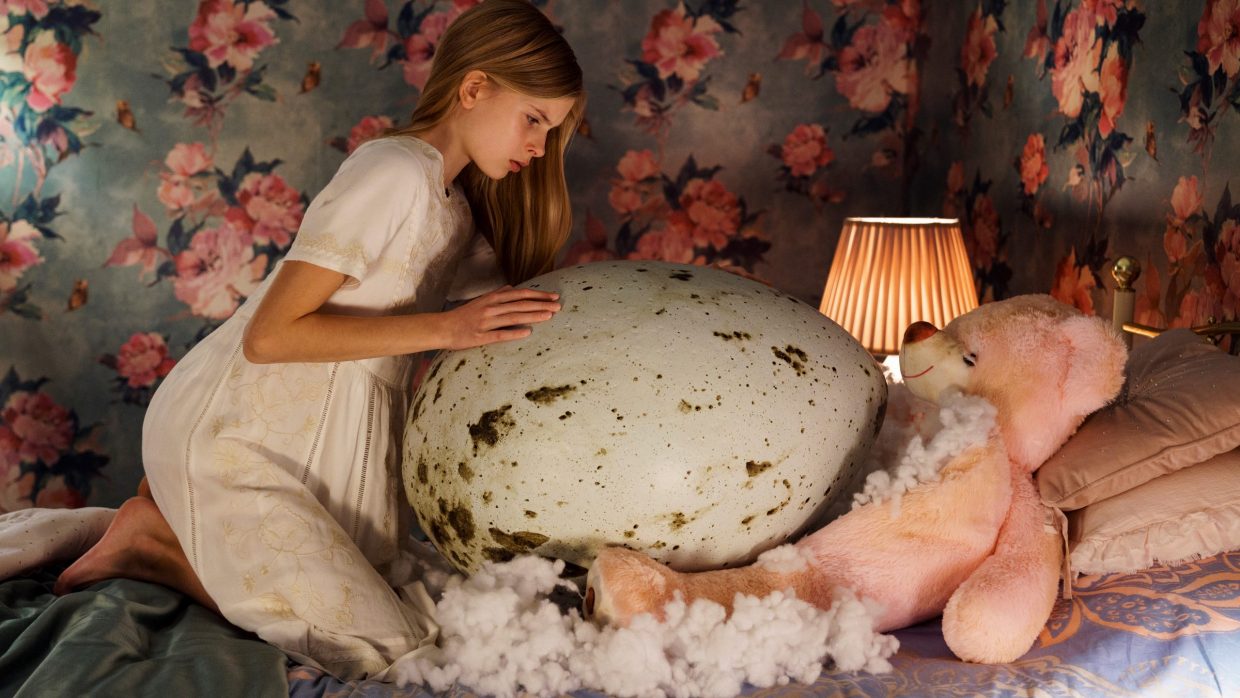 Back to selection
Back to selection
“There Is Always Something to See, Something to Fear”: DP Jarkko T. Laine on Hatching
 Siiri Solalinna in Hatching by Hanna Bergholm. (Photo: IFC Midnight)
Siiri Solalinna in Hatching by Hanna Bergholm. (Photo: IFC Midnight) A lifestyle blog called “Lovely Everyday Life” run by the mother of a friendless tween sounds readymade for satire, and it is, but Hatching also takes it toward horror when the aforementioned tween nurtures and befriends the creature that emerges from a strange egg she finds in the woods. Cinematographer Jarkko T. Laine discusses shooting a horror film that takes place in well lit environs and the difficulties of working with animatronics.
Filmmaker: How and why did you wind up being the cinematographer of your film? What were the factors and attributes that led to your being hired for this job?
Laine: I had previously worked quite a few times with our producers, but with the film’s director it was my first collaboration. I believe it was my previous works and recent jobs done for the same production company that got director’s attention.
Filmmaker: What were your artistic goals on this film, and how did you realize them? How did you want your cinematography to enhance the film’s storytelling and treatment of its characters?
Laine: One of the main goals was to make a horror film that would not be dark and shadowy in a traditional way of thinking. We wanted the horror to happen in light. So even in our low-key scenes and night time sequences the shadows are never really totally black. There is always something to see, something to fear. We also decided early on that even disgusting things should look somehow beautiful. Additionally, choice of focal lengths—choosing wider angles to our young main actress and isolating others from her with longer lenses—was key.
Filmmaker: Were there any specific influences on your cinematography, whether they be other films, or visual art, of photography, or something else?
Laine: I had previously, some years ago, lit one cinema-released thriller very similarly. It was also designed as white as possible, although the story was grim. We did that film with the same production designer, and I am sure some ideas came from that past collaboration. Since that film I have dreamed to be able to shoot a horror film with a visual twist, and here I got it.
Filmmaker: What were the biggest challenges posed by production to those goals?
Laine: The biggest challenge—and a totally new thing to me—was obviously the use of animatronics. All in all, it was my most CGI-heavy project so far, but we had simply excellent on-set troubleshooting, so everything went really smoothly. Another challenge was quite a big studio set, which we needed to light to different moods in a limited time and with little limited sources.
Filmmaker: What camera did you shoot on? Why did you choose the camera that you did? What lenses did you use?
Laine: I shot Hatching with ARRI Alexa Mini because of its compact size and knowing we would do a rather big number of Steadycam scenes. For the lens package I chose ARRI Master Primes simply because I needed fast lenses for the low key studio shoot and some night time exteriors. I also wanted the images to be sharp and crispy, not only for post-production reasons, but because that sharpness suited the story and the cold world of characters. I also like the way Master Primes take the ambient light in.
Filmmaker: Describe your approach to lighting.
Laine: My approach to lighting was like it always is: keep it simple. At the studio set we used lots of practical lights, one reason being that we had rather small windows compared to the (studio) room size. So the practicals helped us to fill the rooms and corridors with our horror ambience. I always try to light in sort of a realistic way as well, even in a horror film like this. The main approach, however, came from that idea of the horror and the painful things happening in light. That meant, for example, filling the shadow areas much more than I usually would.
Filmmaker: What was the most difficult scene to realize and why? And how did you do it?
Laine: Most difficult scenes were those with the animatronics doll combined with puppeteering—trying to hide four puppeteers and get some light in as well to illuminate the rather dark animatronics creature. That was bit of a challenge in all those scenes, and there were quite a few of them.
Filmmaker: Finally, describe the finishing of the film. How much of your look was “baked in” versus realized in the DI?
Laine: My way is always to bake the look in on location or on a studio set as much as possible. Obviously the CGI shots needed to be a little overlit in studio, and they therefore needed more attention in grading as well. But the look of the film was very much created in the shooting.
TECH BOX
Film Title: Hatching
Camera: ARRI ALEXA Mini
Lenses: ARRI Master Primes
